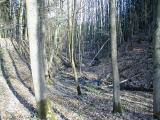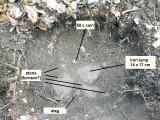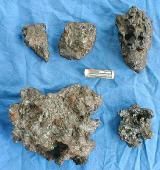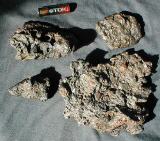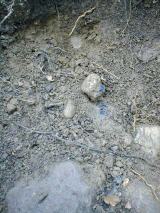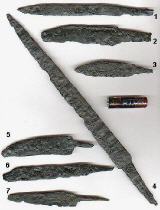Medieval Raw Iron Production at the Creek (3/8)
Raw Iron Production at the Creek
Slowly I moved on upstream. From now on finds were made on a regular basis on the last 50 meters of a 400 m long creek.
Next came larger pieces of sponge iron with some 5 cm diameter, just a few meter apart. These pieces are small so they have often been missed when collecting the sponge iron from the cold iron ore furnace. They were, however, no garbage. It took some 60 kg of wood and many hours of work to produce 1 kg of raw iron so even small pieces were collected. Later a blacksmith re-heated it and hammered it to remove the cavities and slug. Unlike in modern iron works the iron in furnaces of the pre-1500s was not smelted. The melting point of iron is rather high with some 1600 degrees. Medieval or antique furnaces did not reach such temperature. Instead, the iron remained in a solid and porous state – that is why it is called sponge iron - while the slug was mostly melted and poured into small depression besides the furnace. The furnace itself was made from clay, looked like the structures termites build, and was used only once. People liked to erect furnaces adjacent to creeks so they could use water powered bellows.
The Big One
Then nothing for a dozen meters was found and I wondered whether I had reached the end of the hot spot when I got a large deep signal so typical for horse shoes. I dug some 15 cm and reached a layer of clay. I knew that whatever was hidden in the clay was not recent. I dug slowly and carefully. Some 15 cm into the clay and so 30 cm under the surface I found the largest piece of sponge iron I ever found. More than 1 kg in weight, it must have been the main product of the furnace. This picture shows the find in situ, i.e. in its original position.
Group picture sponge iron pieces
This picture shows the found sponge iron pieces. The big one carries several brown pieces which are probably from charcoal and thus can be carbon dated. The countless cavities make mechanical cleaning of sponge iron pieces a nightmare.
Another view on sponge iron group
Another view on the sponge iron pieces.
A furnace?
It is difficult to understand why those who erected and operated the furnace did not take it. Pieces of that size are rare. My theory was that I had found the remains of a furnace with the main iron piece still inside. Slowly I dug further. Not to make a full size excavation but just to find anything to substantiate this idea. So far I had a few large stones and a large piece of sponge iron but this does not make a furnace. Was it possible to find e.g. tubes of baked clay once used to pump the air into the furnace? Then I found this little piece of charcoal.
The charcoal
For the moment that was enough. Though the furnace was still an unproven theory at least I was sure that somebody had operated furnaces near that creek. Sponge iron and charcoal were clear signs.
To dig or not to dig?
At this time I was still at the top level of the stones some 30 cm under the surface. Would further digging reveal a furnace or any other manmade structures? I was tempted to check right now but did not do it. The monument protection authorities, which are quite contra detectorists in my country, always complain about private searchers destroying historical structures. So I decided not to dig further and instead report my observations to them. I also hoped that maybe they would be interested enough to have the found (and carefully wrapped) piece of charcoal C14 carbon dated.
By deciding not to dig I violated a fundamental law of private searchers. Do not procrastinate. If you can dig something today do it. You never know if and when you have the next opportunity to do it. Also, I do not like to contact the authorities because it usually means I am no longer in control of the situation. In my opinion, though, I have earned to be in charge because it was me who spend his precious time finding the place.
Anyway, in my country the relationship between the state’s archaeologists and private searchers is not always full of harmony so I decided not to dig further and report.
Searching the vicinity
When medieval people made iron at this creek they spent hours sitting there and waiting for the chemical processes within the furnace to complete. So I hoped that maybe they lost something and searched the vicinity and in particular the high (=dry) ground above the possible furnace for any lost relics. Partly because of the tight tree cover that took two search days. To my delight I found a knife. A large medieval knife roughly to be dated AD 1000 to 1500. It is number 4 on the picture. The other pictured knifes were found elsewhere. It has a triangle shaped cross section. Heavy quality.
Apart from the knife nothing else of interest was found.
(C) Thorsten Straub www.metal-detecting.de 2006-2019.
